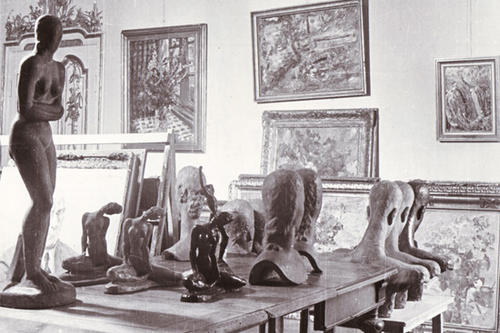Keeping Memory Alive
“Degenerate Art” research center at Freie Universität Berlin publishes database on the whereabouts of 21,000 works of art banned under the Nazi regime
Apr 23, 2010
Depot at Schönhausen Castle with objects by Wilhelm Lehmbruck and Lovis Corinth, ca. 1938/39, Berlin.
Image Credit: Staatliche Museen Preußischer Kulturbesitz, bpk / Zentralarchiv
In 1937, Adolf Hitler ordered the curators of museums and collections in the German Reich to surrender works of art that the National Socialists had labeled “degenerate.” More than 21,000 objects were seized following the order. Now, researchers at Freie Universität Berlin have reconstructed the fates of these works and published them in a database that is available to the public at no charge.
The purge of “degenerate art” led to the defamation, and in some cases the destruction, of works by 1,400 artists, among them George Grosz, Käthe Kollwitz, Paul Klee, and Paula Modersohn-Becker. “Works of modern artistic movements were nearly completely withdrawn from the public eye,” says art historian Andreas Hüneke, who has been working in this field for nearly 40 years. Many of those swept up in the campaign, he says, have now been forgotten.
Working in painstaking detail, Hüneke and his team began their project in late 2002, reconstructing the events surrounding the seizure by the Nazi regime and tracing the paths taken by the paintings, sculptures, and prints from the 1930s to the present day. The researchers are also investigating the fates of the artists who were persecuted, the strategies taken by museum curators, and the role dealers played within the art trade.
Full-text Search and Specific Research Possible
The user-friendly database offers a host of different options: Users can search for full text or for specific artists or genres; the objects can even be grouped according to the defamatory exhibitions organized by the National Socialists at the time to present the works as “degenerate” in many German cities and vilify the artists. All of the objects are listed with the most important relevant facts and provenances, and many of them are linked to image files.
“We are initially publishing 2,500 data records,” says Meike Hoffmann, the coordinator at the research center, which has received most of its funding from the Ferdinand Möller Foundation and the Gerda Henkel Foundation since it was first established. Within the next three years, the center has plans to publish double-checked, updated information on all works confiscated during the purge.
The directory will be a major boon to museum employees when it comes to tracing the provenance of certain works of art – such as in the case of works that were on loan to museums at the time of seizure, which should rightfully go to the heirs of their former owners. The researchers also hope that users will be able to provide information on objects that are still missing.

